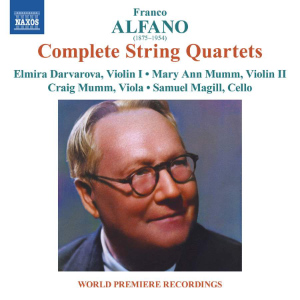
Franco Alfano (1875-1954)
Complete String Quartets
No. 1 in D Major (1914-18 rev. 1924)
No. 2 in Tre Tempi Collegati in C Major (1926)
No. 3 in G Minor (1945)
Elmira Darvarova (violin I), Mary Ann Mumm (violin II), Craig Mumm (viola), Samuel Magill (cello)
rec. 2022, Oktaven Audio, Mount Vernon, USA
Premiere recordings
Naxos 8.579042 [83]
The Italian composer Franco Alfano began life in Naples in 1875, and at the early age of 16 was admitted to the Conservatorio San Pietro a Majella to study piano and composition with Alessandro Longo. From there he progressed to the Leipzig Conservatory for compositional studies with Salomon Judassohn. He briefly toured Russia after graduation. From 1918 he became director of various conservatories in Bologna, Turin and Pesaro. He died in 1954.
He can be credited with the completion of Puccini’s unfinished opera Turandot. His compositions include several operas, four ballet scores, chamber music and works for piano. He composed a cycle of three string quartets (1918, 1926 and 1945), each one cast in three movements.
The String Quartet No. 1 was penned during the World War 1 and revised in 1924. Its opening movement is craggy and asperous and there’s an element of struggle throughout its course. Its harmonies are quite dissonant. A radiant viola solo ushers in the slow movement. It is tender, gentle and consoling, conveying a sense of wistful longing with its pleading tendrils. It was written as a memorial or elegy to his son Herbert, who died serving in the Italian army. The booklet describes the “manic activity” of the finale as running through a full “gamut of emotions”. It’s both tempestuous and highly involved, pushing forward with single-minded resolve.
Alfano scaled things down for his Second Quartet “In Three Linked Movements”. The date of composition is 1925-1926, and the dedicatee is Benito Mussolini. The composer resorted to a more tonal idiom for this work, and he drew on many sources for inspiration, including Russian and Eastern music. A religious fervour of soothing elements imbues the first movement. Child-like simplicity and charm inform the second movement, leading into the finale which is a village dance with a Romanian flavour.
Fast forward twenty years and we have the Third Quartet; after this Alfano permanently took leave of the genre. It was a tragic time for him. Turin had been bombed and his possessions, placed in storage for safe keeping, were destroyed. In 1943 his beloved wife had died. Against this background he penned his String Quartet No. 3 in G minor. He deliberately chose a minor key for the work. It opens with a Largo in disconsolate vein. There are moments of nostalgic recollection and a journey’s end to resignation. The mood lightens in the following movement. It’s a foot-tapping folk dance, with Alfano drawing on Phrygian and Aeolian modes to add spice to the mix. The final movement is intense and driven.
The sound has immediacy and presence, and the balance between the instrumentalists is exemplary. The quartet play with dedication and commitment, and their engaging performances reveal a real love of the music. The cellist Samuel Magill has contributed the liner notes, which contain an informative biography of the composer and detailed discussion of each quartet. This recording deserves to be on the shelves of all chamber music devotees who have a fascination for something a bit out of the ordinary.
Stephen Greenbank
Previous review: Rob Barnett (August 2023)
Help us financially by purchasing from





















